

Catch Fish with
Mike Ladle
Information Page
SEA FISHING
For anyone unfamiliar with the site always check the FRESHWATER, SALTWATER and TACK-TICS pages. The Saltwater page now extends back as a record of over several years of (mostly) sea fishing and may be a useful guide as to when to fish. The Freshwater stuff is also up to date now. I keep adding to both. These pages are effectively my diary and the latest will usually be about fishing in the previous day or two. As you see I also add the odd piece from my friends and correspondents if I've not been doing much. The Tactics pages which are chiefly 'how I do it' plus a bit of science are also updated regularly and (I think) worth a read (the earlier ones are mostly tackle and 'how to do it' stuff).
'Two lessons - you're never too old to learn about fishing!'
Although this is my Saltwater angling page, the tackle and tactics that I use are often identical to the stuff I use for sea fishing. In the past week I've fished in the river and the sea and both were interesting (to me) and produced surprises. Firstly I had a perch fishing session on one of my local rivers. I took two rods (I hate doing that), one for catching baits and the other for the perch. I started off using a little float and small, maggot-baited hook to catch minnows for bait. When I had enough minnows to keep me supplied for five or ten minutes, I switched to the simple paternoster with a size 6 circle hook to wire on the other rod.
I should first describe the conditions. Like many rivers in the country, after our prolonged dry spell, there wasn't much water. The weir, where I'd chosen to fish was only flowing over about a tenth of its width, and the disturbed, white water extended just a few centimetres from the sill. I started, a little after first light, but it was already pretty warm and humid. I was pleased to find that the minnows were on the feed immediately, and I had half-a-dozen swimming in my bucket within about five minutes.
Now I switched to the paternoster. I lip-hooked a minnow and lowered it just beyond the rod tip, into the falling water next to the concrete. Within seconds I felt the bump, bump of a biting perch and, as I tightened the line, I was in. The perch was no monster but, as always, I was pleased to catch one. For the next half hour I caught perch after perch. None of the fish reached a pound in weight and every few minutes I had to switch back to catching a few more baits. After about twenty minutes, having lost the weight in a snag (there are a lot of small rocks at the base of the weir), I changed the set up by simply attaching a split cork, as a float, about one metre above the hook. The new (simple) rig was equally effective and I continued to catch perch as long as my float was close to the sill. On two occasions, as I reeled in a perch, there was a good sized swirl suggesting that something larger was having a snatch at the struggling fish on my line.
It was about time to leave for breakfast and I was thinking "last cast" as I hooked another smallish perch. I allowed the fish to swim round for a few seconds before lifting it from the water and, as I anticipated, after a few seconds the float submerged when the perch was grabbed by a good sized pike. I allowed the line to tighten, the rod bowed and the reel began to buzz as the fish took line against a tight clutch. The pike was on. I was not concerned as I had a wire trace and the tackle was plenty strong enough for anything. I settled down to play the fish. It made several strong runs, each time taking a few more metres of line. The fish was headed out into the middle of the pool and I was confident that it was only a matter of time until I would land it. Then the line went solid. I gave it a shake and pulled from a few different angles but it was soon apparent that the fish had found a solid snag. Heaven knows what it was out there as I'd never found snags in that position before. After five minutes of pulling and waggling the trace parted, presumably leaving the large fish with a small hook in its mouth - I was gutted. I packed in and went home thinking that I'd have to restrain, much more severely, any large fish hooked in that situation. Lesson 1.
ALL the perch were under the small curtain of falling, white water.
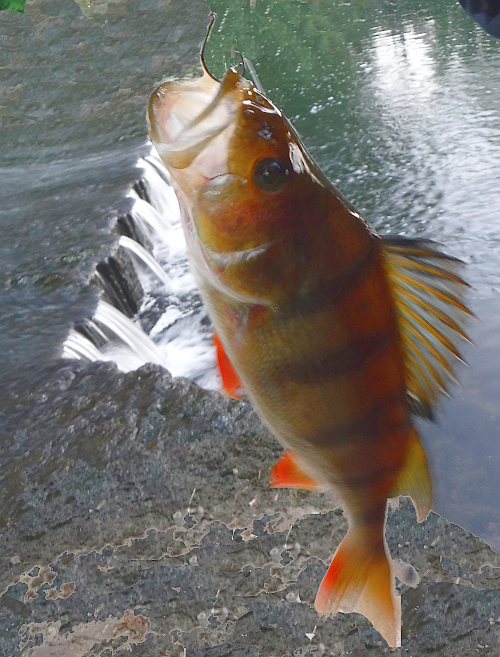
Another perch on the circle hook, none were monsters.
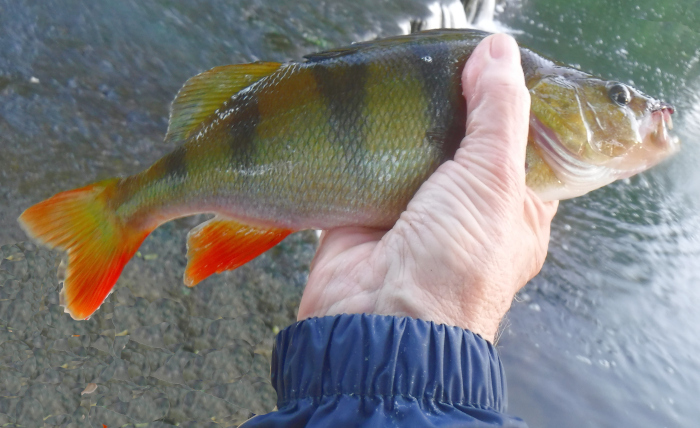
My saltwater trip was another early morning session, this time in search of bass. First light was just appearing in the sky as I approached my chosen venue after a fifteen minute hike over the boulders in the dark. It was just on low water, so I baited up my 8/0 circle hook with a good sized mackerel fillet and spent ten minutes walking about on the flat rocks, for future reference memorising the position of any dips in or boulders on the flat, rocky pavement where I was standing. As I stood I watched until a small rock, which had been 5cm clear of the surface, began to submerge. The tide was rising. Time to fish Mike!
I made my first cast, flicking the bait underhand so that it fell perhaps four or five metres out from the water's edge, in probably 30cm depth. Ten minutes passed and now I was having to inch my way back as the tide crept towards me up the (very) gentle slope. I gently tugged the line to make sure that the bait was not snagged up - it seemed fine. After about another five minutes I reeled in to examine the bait for crab or blenny damage - it was pristine, I should probably have left it. I made another short cast so that the bait landed, a couple of metres to the left of its previous position, in a slight depression that I'd noticed earlier. I took a couple of paces back as the water approached the toes of my waders. Out of the corner of my eye I saw a movement to my right, and looked along to see two anglers, armed with spinning rods, paddling out to fish about 100m away. At least they wouldn't disturb my peaceful little pitch.
I returned to my concentration. It wasn't very long before I felt a slight twitch of the line. My heart seemed to stop for an instant (it always does when I feel a fish). Twitch, twitch again! The braid started to run out between the finger and thumb of my left hand. Faster and faster it went until several metres had gone then, suddenly it stopped. Now, bass have a habit of dropping the bait and, seemingly (if you're lucky) picking it up again. I waited as the seconds ticked away. Had it gone? The suspense was too great so, slowly I wound in and watched as the bowed slack line tightened. Sploosh! The fish was on and the clutch was screeching. The bass fought quite hard but it was soon apparent that it wasn't a very big fish. Before long I was able to slide it ashore, lay down the rod, and take a picture. Now to remove the hook. Where was the hook? I picked the fish up and peered down it's throat, there was the hook-eye. Bugger! I took my pliers out of the bag and reached for the fish again, noticing as I did so that the bass was bleeding. Not good! I gripped the hook shank and with a push and a twist managed to remove the hook. There was more blood, it did not look good. I put the fish back in the water and it rolled onto its back. The tail of the bass was flicking and the gill covers were slowly moving so I gently turned the fish upright and gave it a slight push, it rolled over again and the gentle current of the flooding tide pushed it into shallow water. After five more minutes of nursing it became apparent that the fish wasn't going to survive, so I knocked it on the head and put it in my bag. That would be the only one I had kept to eat this year. Pity it wasn't bigger.
A nice, small bass badly hooked - a very rare occurrence on my big circle hooks.
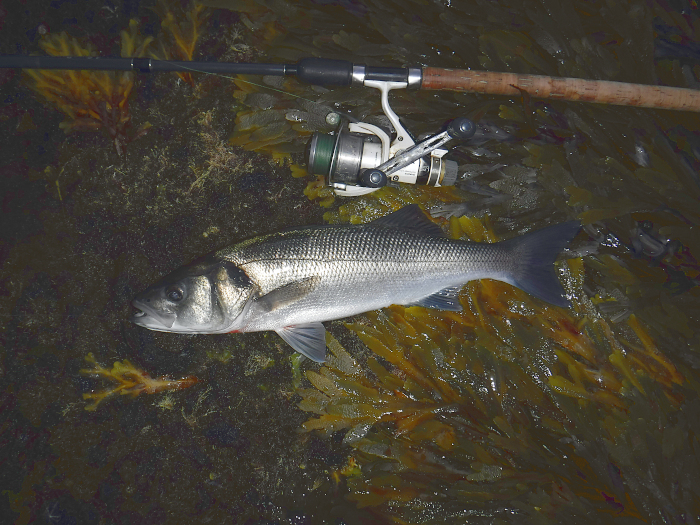
Of course, the interesting thing was that, when the initial run stopped the bass had not dropped or left the bait, as I'd imagined, but was in the process of swallowing it and (presumably) continuing to forage for more food. Adding emphasis to this information, was another fish which I had caught in the same area recently which had taken the bait without me feeling a twitch, a run or anything - it was simply on when I wound in. That one was, typically, jaw hooked. I had been unaware of the presence of either bass on the end of the line. In neither case did I see any disturbance or feel any movement before the fish was hooked - despite the very shallow water in which they were swimming. Lesson 2
– PLEASE TELL YOUR TWITTER, FACEBOOK, EMAIL FRIENDS ABOUT THESE BOOKS.
THE SECOND WAVE

Written with Steve Pitts this is a SEQUEL TO THE BESTSELLER "Operation Sea Angler" IT'S AVAILABLE ON PAPER FROM -
HOOKED ON BASS
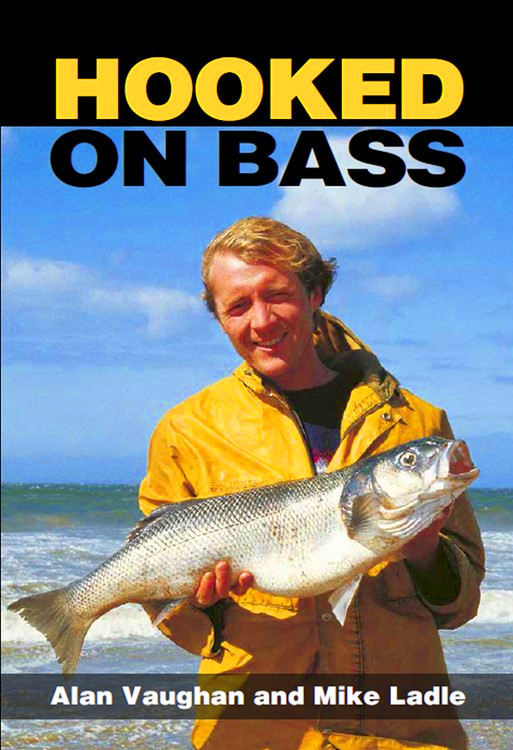
Written with Alan Vaughan. NEW PRINT OF THE ORIGINAL: IN PAPERBACK. Copies available from all good book shops RRP £14:99 -
ANGLING ON THE EDGE
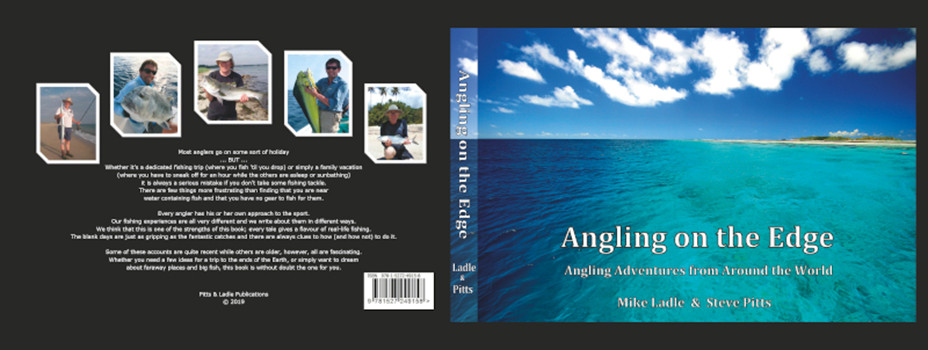
Copies can now be ordered (printed on demand) from Steve Pitts at £34.00, inc. Royal Mail Insured UK Mainland Postage.
To order a book send an E-MAIL to - stevejpitts@gmail.com
FISHING FOR GHOSTS
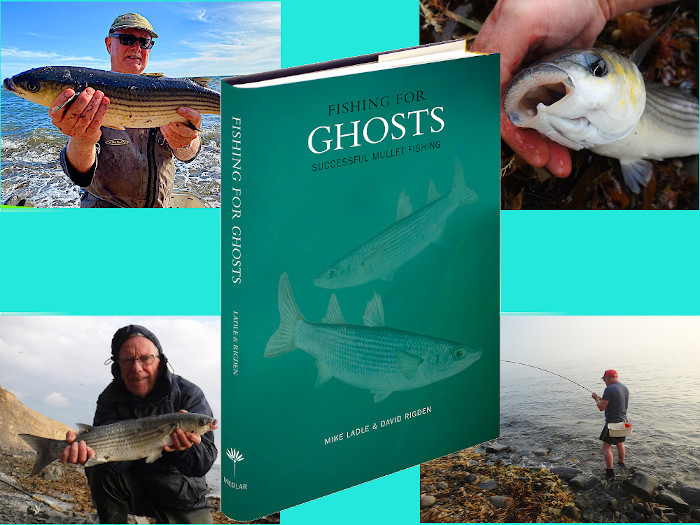
Written with David Rigden. Copies from
If you have any comments or questions about fish, methods, tactics or 'what have you!' get in touch with me by sending an E-MAIL to - docladle@hotmail.com